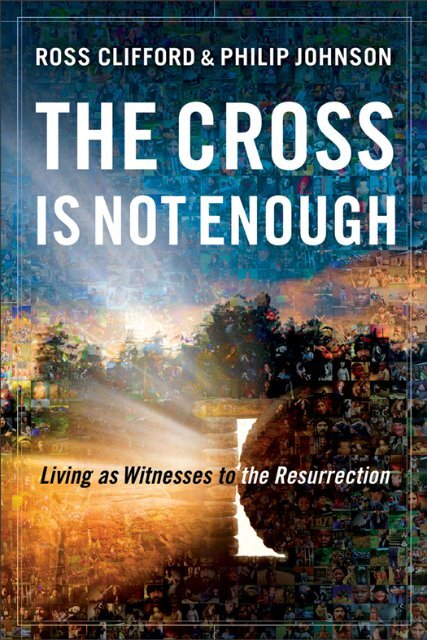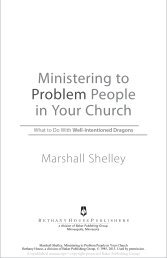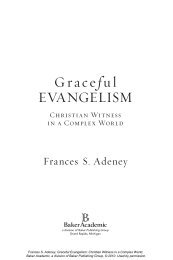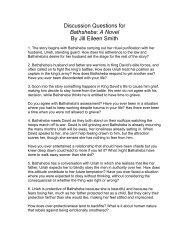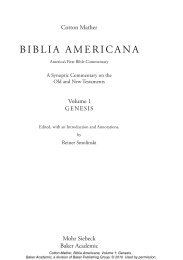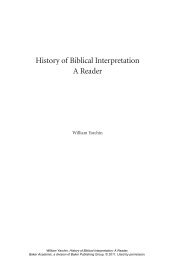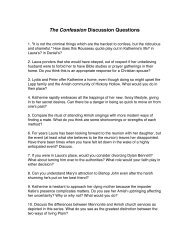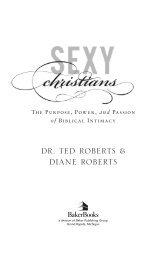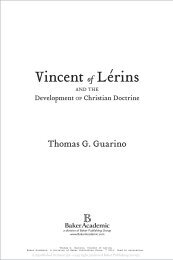abbreviations - Baker Publishing Group
abbreviations - Baker Publishing Group
abbreviations - Baker Publishing Group
You also want an ePaper? Increase the reach of your titles
YUMPU automatically turns print PDFs into web optimized ePapers that Google loves.
“This is not your typical book that approaches Jesus’ resurrection froman evidential or soteriological angle. Clifford and Johnson argue that, ascrucial as it is, the Cross of Christ is not the center of Christianity. Rather,the authors go beyond evidential studies in order to relate Jesus’ resurrectionto a holistic, full-orbed approach to Christian theology, mission,and discipleship, as well as the daily life of the believer. Further, they findechoes of resurrection in many areas of popular culture, including religion,mythology, music, movies, and even comic books. The ‘Spiritual Audit’questions after each chapter serve to challenge personal or group reflection.The authors’ command of popular ideas serves to challenge modernculture, giving this volume a highly distinctive appeal.”Gary R. Habermas, Distinguished Research Professor,Liberty University & Theological Seminary“Have we lost seeing the significance of the resurrection for the Christian?The Cross Is Not Enough argues that we have and then fruitfully walks usthrough the ways we can think about resurrection. It correctly contendswe need to regain an emphasis on the resurrection. Hopefully in doing so,we can see how the resurrection and the cross work together to form thecore of Christian hope.”Darrell L. Bock, Research Professor of New Testament Studies,Dallas Theological Seminary“Christians say that they believe in the cross and the resurrection, but sadlymany Christians focus almost exclusively on the cross and regard the resurrectionas an appendix that God tacked on to prove that Jesus died fortheir sins. In this book, Ross Clifford and Philip Johnson show that manyChristians are operating with a half-told Easter story. Contrary to popularnotions, they explain how the Christian faith is a resurrection faith in therisen Lord. Without the resurrection, Jesus’s death is martyrdom not anatonement, without resurrection Jesus is just another dead Jew not theLord of Glory—the cross derives its meaning and power from the emptytomb. Clifford and Johnson describe what it means to have an authenticresurrection faith that drives theology, missions, spirituality, thinking aboutculture, and church life. If you want to know what to tell your church onEaster Sunday beyond the annual droning of ‘well, there really is life afterdeath, ain’t that nice,’ if you want to know how to be ‘children of theresurrection’ as Jesus said, then for the love of Martha, read this book!”Dr. Michael F. Bird, author, Are You the One Who Is to Come?The Historical Jesus and the Messianic Question;lecturer in Theological Studies, Crossway CollegeRoss Clifford and Philip Johnson, The Cross is not Enough<strong>Baker</strong> Books, a division of <strong>Baker</strong> <strong>Publishing</strong> <strong>Group</strong>, © 2012. Used by permission.
“Ross Clifford and Philip Johnson live in a land where Christians are asmall minority. They have thought long and hard about what it means tobear witness to Jesus Christ when he is little known and less understood.Their reflections on the meaning of the resurrection will be exceedinglyhelpful to disciples who want to understand their own faith and relate itto a post-Christian culture.”Gerald R. McDermott, Jordan-Trexler Professor of Religion,Roanoke College; author, God’s Rivals: Why Has God Allowed DifferentReligions? and World Religions: An Indispensable Introduction“Arguing brilliantly for the resurrection to take back its place on centerstage, this book carries readers on an exhilarating journey through wonderfullyunexpected territory. Immensely practical, with its twelve zonesof resurrection living and apologetic concern for skeptics, and groundedsolidly in Scripture, it marshals astonishingly wide-ranging evidence for theresurrection in culture. Both skillful practitioners, the authors wear theirscholarship lightly and pepper analysis with a wealth of personal storiesand audit exercises. I completed this book with fresh conviction and excitementabout living the resurrection. I know I shall preach differently now.”Michael Quicke, Charles Koller Professor of Preaching &Communications, Northern Baptist Theological Seminary, Chicago“Without the resurrection, Jesus’ death would scarcely have atoned foranyone. So why do treatments of the resurrection focus so little on its theologicalmeaning and practical applications for life in this world? Cliffordand Johnson rectify this problem, but they do much more, showing how theresurrection is the answer to the aspirations of proponents of most of themajor religions of the world and of much of the current popularity of ‘newspiritualities.’ From movies to novels to near-death experiences, our authorsshow amazing command of an array of cultural developments about whichall readers, Christians or otherwise, should be concerned. A must-read!”Craig Blomberg, Distinguished Professor of New Testament,Denver Seminary, Colorado“Inspired by faithfulness to the Bible, and informed by a sophisticatedunderstanding of contemporary culture and the spiritual search of ourgeneration, Ross Clifford and Philip Johnson have written a book that isboth challenging and empowering for all who are concerned to communicatethe heart of the Christian faith to today’s people.”John Drane, author, The McDonaldization of the Churchand Introducing the New Testament; fellow of St John’s College,University of DurhamRoss Clifford and Philip Johnson, The Cross is not Enough<strong>Baker</strong> Books, a division of <strong>Baker</strong> <strong>Publishing</strong> <strong>Group</strong>, © 2012. Used by permission.
“While the title might turn some heads, this book should in fact transformour living. It is a call to responsible and transformational faith flowing outof the hope and reality of the resurrection. Knowing Jesus and believingin Jesus is not enough. The resurrection calls us to believe and live out thepractices and values that Jesus and the resurrection point and empower ustoward. A powerful addition to the call to discipleship and faithful livingas followers of Jesus Christ.”Gary Nelson, president, Tyndale University College and Seminary,Toronto, Canada“Clifford and Johnson are right to want to explore not only how the resurrectionhas been understood in the past, but why it can contribute to thecare and growth of the whole person. A resurrection-centric worldview isconcerned not only with proofs of an empty tomb but also with a distinctlyChristian form of holism. The church today is ready for a book that sees theresurrection as central to the formulation of a holistic Christian worldviewfor post-Christendom today.“Knowing Ross Clifford personally, I know that this subject is not merelyan intellectual exercise for him. It is something that emerges from his ownvery holistic worldview. A book by him on this subject won’t just be stimulatingand ground-breaking, it will crackle with vitality and integrity.”Michael Frost, author, Exiles: Living Missionally in a Post-ChristianWorld; coauthor, The Shaping of Things to Come and ReJesus;Morling College, Sydney“Clifford and Johnson argue that the Good News of Christianity is notjust the cross—that Jesus died for our sins. The Good News is the crossand the resurrection—Jesus died and he rose from the dead. They make acompelling case, one that influences every aspect of Christian living andthinking. A must-read.”Terry Muck, Dean of the E. Stanley Jones School of World Missionand Evangelism Professor of Missions and World Religions,Asbury Theological SeminaryRoss Clifford and Philip Johnson, The Cross is not Enough<strong>Baker</strong> Books, a division of <strong>Baker</strong> <strong>Publishing</strong> <strong>Group</strong>, © 2012. Used by permission.
The CrossIs Not eNoughLiving as Witnesses to the ResurrectionRoss Clifford and Philip JohnsonCRoss Clifford and Philip Johnson, The Cross is not Enough<strong>Baker</strong> Books, a division of <strong>Baker</strong> <strong>Publishing</strong> <strong>Group</strong>, © 2012. Used by permission.
© 2012 by Ross Clifford and Philip JohnsonPublished by <strong>Baker</strong> Booksa division of <strong>Baker</strong> <strong>Publishing</strong> <strong>Group</strong>P.O. Box 6287, Grand Rapids, MI 49516-6287www.bakerbooks.comPrinted in the United States of AmericaAll rights reserved. No part of this publication may be reproduced, stored in a retrieval system, ortransmitted in any form or by any means—for example, electronic, photocopy, recording—without theprior written permission of the publisher. The only exception is brief quotations in printed reviews.Library of Congress Cataloging-in-Publication DataClifford, Ross.The cross is not enough : living as witnesses to the Resurrection / Ross Clifford and PhilipJohnson.p. cm.Includes bibliographical references (p. ).ISBN 978-0-8010-1461-1 (pbk.)1. Resurrection. I. Johnson, Philip, 1960– II. Title.BT873.C65 2012236 .8—dc232011025655Unless otherwise indicated, Scripture quotations are from the New Revised Standard Version ofthe Bible, copyright © 1989, by the Division of Christian Education of the National Council of theChurches of Christ in the United States of America. Used by permission. All rights reserved.Scripture quotations marked Message are from The Message by Eugene H. Peterson, copyright © 1993,1994, 1995, 2000, 2001, 2002. Used by permission of NavPress <strong>Publishing</strong> <strong>Group</strong>. All rights reserved.The internet addresses, email addresses, and phone numbers in this book are accurate at the timeof publication. They are provided as a resource. <strong>Baker</strong> <strong>Publishing</strong> <strong>Group</strong> does not endorse them orvouch for their content or permanence.12 13 14 15 16 17 18 7 6 5 4 3 2 1Ross Clifford and Philip Johnson, The Cross is not Enough<strong>Baker</strong> Books, a division of <strong>Baker</strong> <strong>Publishing</strong> <strong>Group</strong>, © 2012. Used by permission.
ContentsAbbreviations 11List of Figures 13Prologue: Attention All Readers! 15Part One The Resurrection Grid1 The Resurrection Is the Lynchpin 192 The Resurrection Effect: Yours, Mine, and Ours 413 Cynics, Post-Christendom Seekers, and Resurrection 65Part Two Thumbprints of the Resurrection in Culture4 The Resurrection in Popular and High Culture 915 Cultural Expressions of Death-Refusing Hope 1116 Signs of the Resurrection in General Revelation 1277 Other Religions, the Undead, and Resurrection 1418 Understandings of Selfhood and the Resurrection 1619 Myth, Resurrection, and the Human Psyche 18110 Church History and Resurrection Thinking 201Part Three Back to the Bible11 The New Testament 22512 The Hebrew Scriptures 253Part Four Resurrection Horizons13 Resurrection Theses for the Third Millennium 275Notes 2799Ross Clifford and Philip Johnson, The Cross is not Enough<strong>Baker</strong> Books, a division of <strong>Baker</strong> <strong>Publishing</strong> <strong>Group</strong>, © 2012. Used by permission.
AbbreviationsANFAnthQAThRBibSacCBQCHChrLitCoJColloqCRJCSQCSSRBCTJCTQCTRCulRelCulStCurTMDiDidDiJMThEMQEvQERTExAudAnte-Nicene FathersAnthropological QuarterlyAnglican Theological ReviewBibliotheca SacraCatholic Biblical QuarterlyChurch HistoryChristianity and LiteratureConcordia JournalColloquiumChristian Research JournalCistercian Studies QuarterlyCouncil of Societies for theStudy of Religion BulletinCalvin Theological JournalConcordia TheologicalQuarterlyCriswell Theological ReviewCulture and ReligionCultural StudiesCurrents in Theology andMissionDialog: A Journal of TheologyDidaskaliaDialog: A Journal of MormonTheologyEvangelical MissionsQuarterlyEvangelical QuarterlyEvangelical Review ofTheologyEx audituFemTh Feminist Theology: The Journalof the Britain and IrelandSchool of Feminist TheologyGOTR Greek Orthodox TheologicalReviewGreg GregorianumHeyJ Heythrop JournalHTR Harvard Theological ReviewICMR Islam and Christian-MuslimRelationsIDB The Interpreter’s Dictionary ofthe Bible. Edited by G. A. Buttrick.4 Vols. Nashville, 1962.IDBSup Interpreter’s Dictionary of theBible: Supplementary Volume.Edited by K. Crim. Nashville,1976.IJCS International Journal of Children’sSpiritualityIJPsyRel International Journal for thePsychology of ReligionIJSCC International Journal for theStudy of the Christian ChurchIJSysTh International Journal ofSystematic TheologyIRM International Review ofMissionJAAR Journal of the AmericanAcademy of ReligionJAMusSoc Journal of the American MusicologicalSocietyJBL Journal of Biblical LiteratureJBV Journal of Beliefs and ValuesRoss Clifford and Philip Johnson, The Cross is not Enough<strong>Baker</strong> Books, a division of <strong>Baker</strong> <strong>Publishing</strong> <strong>Group</strong>, © 2012. Used by permission.11
12 AbbreviaTIonsJCAJCRJETJETSJJRelStudJParaJPThJRAJRCEJRHJSHJJSNTJSSRJTSJTSALitThLQLTJLWMissMortMusWNICNTNICOTNRSVJournal of ChristianApologeticsJournal of ContemporaryReligionJournal of Empirical TheologyJournal of the EvangelicalTheological SocietyJapanese Journal of ReligiousStudiesJournal of ParapsychologyJournal of PentecostalTheologyJournal of Religion in AfricaJournal of Research onChristian EducationJournal of Religious HistoryJournal for the Study of theHistorical JesusJournal for the Study of theNew TestamentJournal for the Scientific Studyof ReligionJournal of Theological StudiesJournal of Theology forSouthern AfricaLiterature and TheologyLutheran QuarterlyLutheran Theological JournalLuther’s WorksMissiology: An InternationalReviewMortality: Promoting the InterdisciplinaryStudy of Deathand DyingMuslim WorldNew International Commentaryon the New TestamentNew International Commentaryon the Old TestamentNew Revised Standard VersionNPNFNumenPSCFRelArtsRelSRenResQRTRSBETSciCBSecCentSpecSJTSRSTJSVSQThemThToTOTCTSTynBulUUCVCVTWBCWTJWWNicene and Post-NiceneFathersNumen: International Reviewfor the History of ReligionsPerspectives on Science andChristian Faith: Journal of theAmerican Scientific AffiliationReligion and the ArtsReligious StudiesRenascenceRestoration QuarterlyReformed Theological ReviewScottish Bulletin of EvangelicalTheologyScience and Christian BeliefSecond Century: A Journal ofEarly Christian StudiesSpeculum: A Journal ofMedieval StudiesScottish Journal of TheologyStudies in Religion/SciencesReligieusesSacred Tribes JournalSt. Vladimir’s SeminaryQuarterlyThemeliosTheology TodayTyndale Old TestamentCommentaryTheological StudiesTyndale BulletinUnitarian UniversalistChristianVigiliae ChristianaeVetus TestamentumWord Biblical CommentaryWestminster TheologicalJournalWord and WorldRoss Clifford and Philip Johnson, The Cross is not Enough<strong>Baker</strong> Books, a division of <strong>Baker</strong> <strong>Publishing</strong> <strong>Group</strong>, © 2012. Used by permission.
List of FiguresFigure 1.1: The Centrality of the Resurrection in Acts 20Figure 2.1: Twelve Resurrection Zones for Living 43Figure 2.2: The Resurrection Grid 62Figure 6.1: Approaches to Sharing Faith from Nature 137Figure 6.2: Does the Natural World Speak of God? 138Figure 7.1: Who Believes What on the Afterlife 156Ross Clifford and Philip Johnson, The Cross is not Enough<strong>Baker</strong> Books, a division of <strong>Baker</strong> <strong>Publishing</strong> <strong>Group</strong>, © 2012. Used by permission.13
PrologueAttention All Readers!What’s so special about our book as compared to other books about the resurrection?Unlike other books, ours is a one-stop-shop book that seeks to coverfacets of the resurrection as it applies to daily life, mission, culture, discipleship,theology, and the church. It also uniquely challenges today’s entrenched mindsetthat focuses exclusively on the cross as the lynchpin for Christian living. Itis written for the followers of Jesus, whether they are church leaders, teachers,or those wondering if there is anything beyond the cross. Until we refocus onthe resurrection all the chatter about a new day for the church is paralyzed.Here’s an overview of some of the main ingredients to our book:• We believe in both the death and physical resurrection of Jesus, but webelieve that the church has seriously neglected the resurrection.• Very few Christians realize that while the cross is vital, Jesus’s resurrectionis the theological lynchpin for every aspect of our living, thinking,and doing. We will offer fresh insights about the holistic effect of theresurrection. This new way of thinking involves a paradigm shift fromthe cross to the resurrection, and it asks what the appropriate symbolis for today’s church.• The resurrection can show us how to move beyond feeling like alienatednonpersons. We will offer an understanding of the resurrection that isabout being empowered to live.• The theology of resurrection is at the heart of Paul’s worldview andthe apostles’ missionary messages in Acts. Resurrection theology is alsopresent in the Old Testament, though scholars have traditionally underestimatedit.Ross Clifford and Philip Johnson, The Cross is not Enough<strong>Baker</strong> Books, a division of <strong>Baker</strong> <strong>Publishing</strong> <strong>Group</strong>, © 2012. Used by permission.15
16 Prologue• The resurrection is important for our understanding of who Jesus is.It also affects ethics, creation, human rights, spiritual growth, pastoralcare, and missions.• We take you outside the safe walls of the church and examine numeroussigns of the resurrection in pop and high culture, in the natural world,and in other religions and postmodern spirituality. We explore howthese signs find fulfillment in the resurrected Jesus.• This book is not just another apologetic defense of Jesus’s resurrection.Yes, we will make a case for the resurrection in the context ofmissions, evangelism, and apologetics, but that is not the primaryfocus of the book.• Unlike some books on the resurrection, we offer practical advice onhow to talk to new spirituality seekers, atheists, and skeptics.Each part of this book takes a different approach to understanding theresurrection and its implications for our lives, and we think you’ll understandus best if you take the time to study this book in its entirety. We hope youfind your reading both stimulating and enjoyable.Ross Clifford and Philip Johnson, The Cross is not Enough<strong>Baker</strong> Books, a division of <strong>Baker</strong> <strong>Publishing</strong> <strong>Group</strong>, © 2012. Used by permission.
TheResurrectionGridP a r t O n eIf the Church had contemplated the Empty Tomb asmuch as the Cross of its Lord, its life would have beenmore exhilarating and its contribution to the world morepositive than has been the case.George Beasley-Murray 1Ross Clifford and Philip Johnson, The Cross is not Enough<strong>Baker</strong> Books, a division of <strong>Baker</strong> <strong>Publishing</strong> <strong>Group</strong>, © 2012. Used by permission.
1The Resurrection Is the LynchpinWhy do you keep filling gallery after gallery with endless pictures of the one everreiteratedtheme, of Christ in weakness, Christ upon the cross, Christ dying, mostof all Christ hanging dead? Why do you concentrate upon that passing episode,as if that were the last word and the final scene, as if the curtain dropped uponthat horror of disaster and defeat? Paint Christ not dead but risen, with His footset in scorn on the split rock with which they sought to hold Him down! PaintHim the Conqueror of death! Paint Him the Lord of Life! Paint Him as whatHe is, the irresistible Victor who, tested to the uttermost, has proved Himselfin very deed mighty to save!Tommaso Campanella 1Is your view of the cross too big, and your understanding of resurrection toosmall? Do you see Jesus’s atoning death as the “last word” about the gospeland salvation? Have you ever wondered what Paul meant when he said thatChrist was raised for our justification (Rom. 4:25)?These provocative questions flow from Tommaso Campanella’s fourhundred-year-oldcomplaint about a surfeit of paintings on the crucifixion.Campanella’s complaint suggests that there may be forgotten truths aboutthe resurrection that ought to be rediscovered. The shortage of resurrectionthemedartwork is just the tip of the iceberg, but it indicates that the resurrectionis often taken for granted. Worse than that, the beneficial effects of theway of the risen Jesus are neglected in many important aspects of Christianlife and thought.Ross Clifford and Philip Johnson, The Cross is not Enough<strong>Baker</strong> Books, a division of <strong>Baker</strong> <strong>Publishing</strong> <strong>Group</strong>, © 2012. Used by permission.19
20The ResurreCTIon GridOut of Many, One PhotographPhilip was walking by a bus shelter one day that displayed a large advertisementfor the environmental charity work of Oxfam. From the distance hecould see a photo of a young guy, along with the slogan, “Who is really facingthe impacts of climate change?” What was fascinating about the ad was thatclose-up the photo of the young guy faded and his silhouette was replacedby a jigsaw puzzle of smaller photos. Depending on your vantage point, youcould see lots of micro photographs or one large one.The church today, certainly in the West, is at the crossroads, and it isunderstandably picking at micro pieces of the puzzle: we must be missional,we must preach repentance, we must be moral, we must pray for revival,we must be kingdom-oriented, we must connect with post-Christendomspirituality, we must have multisensory worship, we must rediscover thefundamentals, we must challenge Islam. This book will argue, however,that the church needs to step away from the smaller pieces of the puzzleand take time to recognize and focus upon Christianity’s lynchpin. We areconvinced that there is a major theological picture that the rest of theselittle theological pictures hang from, and that this theological lynchpin isin fact the resurrection.Jesus’s world was also plagued with similar kinds of micro struggles, andthe early faith community understood the small puzzle pieces. They had adifferent methodology for ministering to the Jews, as against the Greeks.They had to face religious challengers and discover the fundamentals of theirfaith. Yet the speeches and sermons in the book of Acts show that, even asthey dealt with the micro questions, the early church did not lose sight ofthe larger picture.F i g u r e 1.1The Centrality of the Resurrection in Acts 2100% 88% 88% 63% 63% 50% 50% 38%resurrection death/suffering OT fulfilment Christ/Lord forgiveness repentance witness judgmentFigure 1.1 is reproduced by permission from Mark Barry, “The Centrality of the Resurrection inActs,” SALT magazine (Autumn 2009): 10.Figure 1.1 shows us that the resurrection received the greatest emphasis inActs and therefore should have the central place in our theology. However,the central photo has instead become the cross. The early church would nothave agreed, as Walter Martin explains:Ross Clifford and Philip Johnson, The Cross is not Enough<strong>Baker</strong> Books, a division of <strong>Baker</strong> <strong>Publishing</strong> <strong>Group</strong>, © 2012. Used by permission.
The ResurreCTIon Is the LynchPIN21What was the central truth of the early apostles’ preaching? What was the stimulusto the miraculous growth of the early church? What was the energizing forcewhich spread the gospel across the face of the earth? The answer to all thesequestions is the Resurrection of Jesus Christ. “He is risen!” was the victoriouscry of the early Christians, and they spread it to the ends of the earth. 3Martin’s comments struck a chord with us recently, when, at a church-plantingconference, we heard speaker after speaker argue that the key Christian messageis the cross with the atonement. Not once was the resurrection mentioned. 4We intend to demonstrate in this book how the micro pictures—morality,repentance, discipleship, apologetics, mission—although valid, only have fullmeaning when they have the resurrection as their fountainhead.Hammering on the DoorWhen Martin Luther hammered up his ninety-five theses on the castle door atWittenberg his catchcry was “ ‘The Cross, the Cross’ and there is no cross.” 5Elsewhere he spoke of the cross as being the test of everything, and there areChristians today who also esteem that “test” as if it is the theological be-alland end-all. 6 Luther had numerous historical and theological reasons for hisoverriding concern about Christ’s atoning death, and the Protestant Reformerswho followed in his wake likewise emphasized the cross as the symbol ofsalvation, justification, and atonement. Many seem to have forgotten, though,that in his sermons and commentaries Luther also spoke about the centralityof Jesus’s resurrection:When one wants to preach the Gospel, one must treat only of the resurrectionof Christ. For this is the chief article of our faith. . . . The greatest power offaith is bound up in this article of faith. For if there were no resurrection, wewould have no consolation or hope, and everything else Christ did or sufferedwould be futile. 7It is not enough that we believe the historic fact of the resurrection of Christ.. . . But we must believe also the meaning—the spiritual significance of Christ’sresurrection, realizing its fruits and benefits, that which we have received throughit, namely, forgiveness and redemption from all sins. 8Those fascinating remarks point to a side of Luther’s thinking that is notoften emphasized. He certainly believed in both Jesus’s death and physicalresurrection. In theology such balances are called both/and, in contrast toeither/or. However, Luther believed that the resurrection involved more thanjust an affirmation that Jesus rose from the dead on Easter Sunday. Luthersaw the need for believers to embrace it and apply its “fruits and benefits.”Ross Clifford and Philip Johnson, The Cross is not Enough<strong>Baker</strong> Books, a division of <strong>Baker</strong> <strong>Publishing</strong> <strong>Group</strong>, © 2012. Used by permission.
22The ResurreCTIon GridThe principal benefit he emphasized is the resurrection’s importance for oursalvation. Luther could hardly have missed this point because Paul himself saidthat Christ was raised for our justification (Rom. 4:25). This is a forgotten truthwe must rediscover: the cross is not enough because it is not the “last word”!We need to be both/and believers concerning the death and physical resurrectionof Jesus. When the church separates the cross and the resurrection,its theology, mission, ethics, and pastoral ministry needlessly suffer fromlopsidedness. That imbalance is just one reason—among several others—that compels the authors of this book to hammer up our statement on thecastle door. Our catchcry is, “ ‘The Resurrection, the Resurrection’ andthere is no resurrection.” In light of the past five hundred years of churchhistory, maybe Luther—if he was walking around today—would even joinus in our “protest.”An Unraveled GarmentBefore you doubt what we have just said, please bear with us for the next fewpages. We feel strongly that the church has lost its grip on the centrality ofthe resurrection. We are not saying that the resurrection has vanished fromthe church’s confession; indeed, most Christians have believed in the physicalresurrection of Jesus Christ. It is affirmed in church gatherings in creeds,liturgies, prayer-books, and catechisms, and in the lyrical content of hymnsand choruses. The resurrection is affirmed in formal doctrinal statements ofchurches, parachurch ministries, and missionary agencies.The resurrection is deeply embedded in the fabric of Christianity, but it isgenerally only talked about in isolated contexts and often in truncated form.Take a moment to consider three examples in which the resurrection surfacesin diverse but isolated church settings (and even there it is not as it should be):• Easter Sunday: We all affirm Jesus’s victory over death in the liturgicalcalendar. Actually, every Sunday is a symbolic reminder of the dayof Christ’s resurrection: the early church chose to worship on Sundayinstead of the Sabbath or Friday (the day Jesus died). Each Sundayought to be a time of celebratory renewal because of the resurrection.Easter is supposed to be a perpetual experience: “Sunday is not just acommemoration of a historical event but a realization (both the awarenessand a making real) of union with the risen and reigning Christ bythe power of the Holy Spirit.” 9 That is why we see so much emphasison the resurrection in the book of Acts. As part of our conversationwith you we put this question: Are church practices about the resurrectiononly about a past miraculous event that is, like Christmas, tobe celebrated annually?Ross Clifford and Philip Johnson, The Cross is not Enough<strong>Baker</strong> Books, a division of <strong>Baker</strong> <strong>Publishing</strong> <strong>Group</strong>, © 2012. Used by permission.
The ResurreCTIon Is the LynchPIN23• Pastoral Comfort: You probably have experienced resurrection talk inpastoral words of comfort at funeral services. One snag, though, is thatmost Christians tend to be very fuzzy about the general resurrection ofhumanity. N. T. Wright has recently highlighted that many do not reallyunderstand that the resurrection of the dead involves us on a new earth,but instead believe in an immortal soul or a disembodied spirit thatfloats on the clouds. 10 How many pastors comfort us by connecting ourholistic resurrection to the “new earth” (Isa. 65:17; 2 Pet. 3:13; Rev. 21)and how that impacts us now? We put it to you: Is the resurrection onlyconcerned with comforting us in grief to bolster our hope for a spirituallife after death?• Answering Skeptics: Like us you have probably read books that stoutlydefend the testimony and historical evidences for the resurrection. Thediscipline of apologetics involves giving reasons for faith, and the resurrectionlooms large in that genre. Apologetics texts play their part inencouraging faith, rebutting debunkers, and assisting in our witness tonon-Christians. Apologists argue that the evidences show that Jesus hasrisen from the dead, and the resurrection is the sign that he is the Son ofGod (John 20:24–28; Rom. 1:4). Most apologists stop at this juncture,though, and do not explain the implications of a resurrection-basedfaith. We put it to you: Why do apologists boldly declare that “you canbelieve” but then almost never bother to explain what practical differencethe resurrection makes in the lives of those who follow Christ?Jesus’s resurrection should be the focal point on Easter Sunday, as well as inpastoral comfort and answering skeptics, but those settings are still not enough!Like a woolen sweater, the resurrection consists of many threads that unitein a seamless garment. Unfortunately, individual threads are unraveled fromparts of the Bible and then tailored to suit a given context: pastoral comfortfor bereavement, and apologetic evidences for bolstering faith in the Easterevent. Often the threads are disconnected when they should be referred backto the whole garment.Our great worry is that the church has failed to understand the resurrectioncomprehensively and to apply it holistically to life. The apostles understoodthe resurrection as the lynchpin of Christianity—integral to every aspect oflife and thought—and therefore, so should we.Resurrection EclipsedAll of us are familiar with a solar eclipse, during which the moon passesbetween the earth and sun. From our vantage point on the earth the moon’sshadow completely obscures from vision the disk of the sun. During an eclipseRoss Clifford and Philip Johnson, The Cross is not Enough<strong>Baker</strong> Books, a division of <strong>Baker</strong> <strong>Publishing</strong> <strong>Group</strong>, © 2012. Used by permission.
24The ResurreCTIon Gridonly the sun’s corona is visible around the moon’s rim. Just as the moon’sshadow obscures the sun, the cross often overshadows the resurrection. Theresurrection has not been intentionally obliterated—after all even in a theologicaleclipse the corona is still present. It does, however, mean that a fullview of the resurrection is obscured.Solar eclipses have a short duration and then the sun reappears, but the resurrectionhas been eclipsed for a long time and remains stuck in the shadows.We are not satisfied with the corona of the resurrection peeping from behindthe cross. We want to see the entire disk of the resurrection shining across thetheological, missional, ethical, and pastoral sky! We will now briefly illustratehow the eclipse of the resurrection is unwittingly perpetuated.John Stott: An Elder StatesmanWe esteem John Stott as an elder statesman among Protestant and Anglican-Episcopalian evangelicals. One of the first books that we give to new seminarystudents is Stott’s book The Cross of Christ. 11 Stott has many valuable thingsto say about the atonement and redemption that we affirm, and we want toemphasize that we are not calling for a reappraisal of the atonement. 12 Instead,we want everyone to think about what constitutes Christianity’s lynchpin—isit the cross or the resurrection?Nobody can doubt that Stott is a both/and believer in the death and physicalresurrection of Jesus:The church was founded on the resurrection. Disprove the resurrection, and thechurch would have collapsed. 13However, Stott has always swayed towards making the cross preeminent byinsisting that it is at the heart of the gospel:The cross is at the center of the evangelical faith. Indeed, as I argue in thisbook, it lies at the center of the historic, biblical faith, and the fact that thisis not always everywhere acknowledged is in itself a sufficient justification forpreserving a distinctive evangelical testimony. 14According to Stott the message of the cross is preeminent because it liberatesand transforms us. 15 The way we understand ourselves before God and leadour lives under Jesus’s lordship is shaped by the cross:It would be seriously unbalanced to proclaim either the cross without the resurrection(as I am afraid Anselm did) or the resurrection without the cross (as dothose who present Jesus as a living Lord rather than as an atoning Savior). It istherefore healthy to maintain an indissoluble link between them. . . . [T]he gospelRoss Clifford and Philip Johnson, The Cross is not Enough<strong>Baker</strong> Books, a division of <strong>Baker</strong> <strong>Publishing</strong> <strong>Group</strong>, © 2012. Used by permission.
The ResurreCTIon Is the LynchPIN25includes both the death and resurrection of Jesus, since nothing would havebeen accomplished by his death if he had not been raised from it. Yet the gospelemphasizes the cross, since it was there that the victory was accomplished. 16Consider what Stott told the Southern Baptist Al Mohler shortly after TheCross of Christ was published:I think we need to get back to the fact that the cross is the center of biblicalChristianity. We must not allow those on the one hand to put the incarnationas primary, nor can we allow those on the other hand to put the primary focuson the resurrection. Of course, the cross, the incarnation, and the resurrectionbelong together. There could have been no atonement without the incarnationor without the resurrection. The incarnation prepares for the atonement andthe resurrection endorses the atonement, so they always belong together. Yetthe New Testament is very clear that the cross stands at the center. Of course,we preach the whole of biblical religion, but with the cross as central. 17Nobody should be very surprised that the cross is paramount in Stott’stheology. In Evangelical Truth he summarizes what others have had to sayabout the leading features of evangelicalism: “Each began with the supremacyof Scripture and the majesty of Christ, particularly of his cross.” 18 In thisregard Stott also relies on the earlier efforts of the Scottish theologian JamesDenny. Denny wrote the classic work The Death of Christ at a time whenhe felt that the cross and atonement needed to be defended and emphasized.Like Stott he valued the resurrection, but reading his text shows that hislynchpin is the cross. In fact he felt free to add the atonement to the primitivespeeches in Acts:Even if the book of Acts were so preoccupied with the resurrection that it paidno attention to the independent significance of the death, it would be perfectlyfair, on the ground of this explicit reference of St. Paul, to supplement its outlineof primitive Christian doctrine with some definite teaching on atonement. 19Stott has consistently placed the message of the cross at the center so thatwe rejoice in Christ in both hope and suffering in this present life.Resurrection and JustificationWhen it comes to justification Stott insists that the cross alone stands forJesus’s atonement for sin and the defeat of death. 20 He limits the resurrectionto the vindication of the cross:What the resurrection did was to vindicate the Jesus whom men had rejected,to declare with power that he is the Son of God, and publicly to confirm thathis sin-bearing death had been effective for the forgiveness of sins. 21Ross Clifford and Philip Johnson, The Cross is not Enough<strong>Baker</strong> Books, a division of <strong>Baker</strong> <strong>Publishing</strong> <strong>Group</strong>, © 2012. Used by permission.
26The ResurreCTIon GridStott’s explanation of the relationship between the cross and resurrection, inour view, is inadequate. As we explore in chapter 11, his suggestion that theresurrection endorses the atonement barely scratches the surface of its theologicalimportance. Even though he believes there is an indissoluble unity betweenthe cross and resurrection he fails to do justice to Paul’s deeper thinkingabout it. Michael Bird implies that Stott’s understanding of the resurrectionin relation to justification is superficial and reductionist:In reading the Pauline epistles one is struck with the suspicion that the resurrectionis far more intrinsic to justification than merely comprising an authenticationthat our justification has taken place at the cross. 22The Cross of Christ shows very clearly that Stott does not see Jesus’s resurrectionas the theological lynchpin, but instead views the cross as the center ofbiblical Christianity. We accept that the cross is an indispensable part of thegospel’s message of reconciliation, and that it shows us the obedience, humility,and servanthood of Christ and forgiveness of sin in his atoning death. However,we see the effect of the resurrection as having a holistic and harmonious impactthat the cross alone cannot deliver. The resurrected Jesus transforms us throughboth cross and resurrection. The cross alone is not enough, whereas the implicationsof the resurrection as the theological lynchpin are all-encompassing.The LegacyThe Lausanne movement is a worldwide network of evangelicals whose foundingfathers are Billy Graham, Leighton Ford, and John Stott. Its 1974 covenant is awell-rounded creedal statement adopted by many church and parachurch groups.While Lausanne papers have strongly affirmed the fact of the resurrection ofJesus, little appears to be said about its status as the holistic lynchpin of Christianbelief. The cross-centered redemptive message eclipses the resurrection.The Evangelical Review of Theology dedicated an edition to foreshadowingthe 2010 Lausanne world forum in Cape Town, South Africa. The collectedpapers had the theme of the “whole gospel,” which represented a project ofLausanne’s theological working group. One paper placed the emphasis on“The Gospel and the Achievement of the Cross” and discussed in some detailvarious theories of the atonement. The author’s clarion call was for both“Christians and churches to be thoroughly cruciform.” 23 Other papers reflectedon the gospel in biblical revelation, the gospel in the power of the Spirit, andthe gospel and ethics, but surprisingly it is difficult to find any clear or explicitconnection of these themes to the resurrection. 24 The resurrection is clearlynot at the center in these papers, and the uncanny sense they convey is that theresurrection’s sole purpose is to allow one to live out the sufferings of the cross.Ross Clifford and Philip Johnson, The Cross is not Enough<strong>Baker</strong> Books, a division of <strong>Baker</strong> <strong>Publishing</strong> <strong>Group</strong>, © 2012. Used by permission.
28The ResurreCTIon GridChapel SermonAnother curious example of cross-centered Christian belief occurred in achapel service at our seminary. The preacher was talking on Romans 8:28–39in order to pastorally address Paul’s assurance that in Christ we are more thanconquerors. His practical and inspiring sermon reminded us of Paul’s words,“For I am convinced that neither death, nor life, nor angels, nor rulers, northings present, nor things to come, nor powers, nor height, nor depth, noranything else in all creation, will be able to separate us from the love of Godin Christ Jesus our Lord” (vv. 38–39). Then there came the crunch: “How canwe be sure of this truth?” he asked. His answer was, “The cross!” The crossis the justification, the warrant of our “victory” in Christ. His concludingillustration called us to the cross.The interesting part of this anecdote is that this preacher “gets” the resurrection.In a friendly chat after chapel one of us asked him, “Why did youconclude with the cross?” He admitted that falling back on the cross is whatwe do instinctively, but on reflection he concurred that Paul’s gate to his “high”Christology in Romans 8 begins with the cross (v. 32) but climaxes with theresurrection: “It is Christ Jesus, who died, yes, who was raised, who is at theright hand of God, who indeed intercedes for us” (v. 34). God is batting onhumanity’s side against the adversary—hardship, death, whatever—and theresurrection in this passage is our ultimate confidence for such a promise. Aninteresting conversation followed amongst some of the faculty as to how ourbeliefs have been so shaped that, without thinking, we go into autopilot andrest in the cross—even when Scripture demands otherwise.Transatlantic HeritageThe emphasis on the cross as a defining feature of modern evangelical beliefis something that has been observed by historians on both sides of theAtlantic. In Great Britain David Bebbington notes there is a pattern of fourprominent convictions that consistently appear in history as distinguishingemphases among British evangelicals: the Bible, conversion, personal activism,and preaching of the cross (“crucicentrism”). 27 The same emphases canbe traced throughout the history of the British colonies of Canada, Australia,and New Zealand. 28A similar observation is found in George Marsden’s discussions on howto define American evangelicals. Marsden indicates that it is possible to describeevangelicalism in two different ways. One understanding sees it as “aconceptual unity” of beliefs and practices, while another regards it as a dynamicmovement inside modern Protestantism. Marsden lists its five principalunifying features: the authority of the Bible, the historical aspect of God’sRoss Clifford and Philip Johnson, The Cross is not Enough<strong>Baker</strong> Books, a division of <strong>Baker</strong> <strong>Publishing</strong> <strong>Group</strong>, © 2012. Used by permission.
The ResurreCTIon Is the LynchPIN29Two Roman Catholic Scholars Speak 29Catholic Stations of the cross stop at the burial of Jesus and fail to include a stationof the Resurrection. But there should be little need to pile up further evidenceto establish the fact that Western Christianity has concentrated on Calvary andneglected to celebrate adequately the resurrection.Gerald O’CollinsOur present hope in the face of all the challenges of life, suffering and death, isan effect of the resurrection. Unless that had happened, hope would at best bea repressive optimism, or an accommodation to routine despair. But the effectof the resurrection is to see the world and to live in it otherwise. . . . In fact it isso taken for granted that the originality of the resurrection’s effect on the life offaith can be forgotten. What originally made all the difference gradually becomesa remote presupposition, only vaguely affecting the way we understand God,ourselves and the world itself.Anthony Kellysaving work in the Bible (the cross), salvation and conversion in Christ, thepriority of evangelism and missions, and a spiritually changed life. 30 NeitherBebbington nor Marsden mentions the resurrection as a central belief ofevangelicalism.Continuing EclipseAn overemphasis on the theology of the cross leads to a lack of a resurrectionbasedperspective in other areas of theology such as ethics, pastoral ministry,and spiritual growth. We focus on these matters more in chapter 2 but beloware a few brief examples.Theology and SpiritWhen theologians overemphasize the outpouring of the Holy Spirit atPentecost, we end up seeing only the “corona” of Jesus’s resurrection. BothJesus’s resurrection and ascension took place prior to Pentecost, and theseevents are often presupposed by theologians who concentrate on the work ofGod’s Spirit on the church. It is understood that the Spirit of the risen Jesushas been poured out on the church, but the centrality of the resurrection messagein Acts is curiously bypassed. 31 Resurrection theology recedes as the giftof the Holy Spirit and the use of spiritual gifts take center stage. A lopsidedRoss Clifford and Philip Johnson, The Cross is not Enough<strong>Baker</strong> Books, a division of <strong>Baker</strong> <strong>Publishing</strong> <strong>Group</strong>, © 2012. Used by permission.
30The ResurreCTIon Gridemphasis on exuberant aspects of faith can obscure the holistic role of theresurrection in the pilgrimage of the church.MissionsIn the book of Acts Paul’s missionary messages are grounded in declaringthe risen Christ to both Jew and gentile. David Bosch observes:The most common summary of the early church’s missionary message was thatit was witnessing to the resurrection of Christ. It was a message of joy, hope,and victory, the first fruit of God’s ultimate triumph over the enemy. And in thisjoy and victory believers may already share. 32Bosch believes that for our era “the central theme of our missionary messageis that Christ is risen,” so that as a consequence “the church is called to livethe resurrection life in the here and now and to be a sign of contradictionagainst the forces of death and destruction.” 33In the literature of today’s missions, however, the resurrection is often notthe central holistic theme. Models of modern missions typically present twopolarized tasks: the imperative to make disciples by announcing salvation inthe cross of Christ, and the imperative to pursue social justice. These twintasks have been thought of as either/or imperatives rather than holisticallyas both/and. N. T. Wright says that “the split between saving souls and doinggood in the world is a product not of the Bible or the gospel but of the culturalcaptivity of both within the Western world.” 34 The missing link that justifiesand sustains the both/and for the church’s mission is the resurrection.Wright puts it in a nutshell by saying that the church’s mission is “nothingmore or less than the outworking, in the power of the Spirit, of Jesus’ bodilyresurrection.” 35Interreligious DialogueThe same problem ensues in the church’s encounter with other religions.Timothy Tennant’s imaginary evangelical roundtable dialogues with Hindus,Buddhists, and Muslims do not have the message of the resurrection at theircenter. He mentions the resurrection in one sentence in dialogue with Buddhistsand in just a page in dialogue with Muslims. In the Islamic context Tennantis quite right to address disbelief about the crucifixion, which in turn has abearing on the resurrection as an event. He echoes the common mantra aboutthe death of Christ being the “central feature of the Christian message.” 36A spectrum of views abounds in Roman Catholic literature on interfaithdialogue. William Thompson and Anthony Kelly stand out as Catholics whoacknowledge the need to reshape interreligious dialogue based around theresurrection. 37 In the Anglican tradition Bishop Michael Nazir-Ali has said:Ross Clifford and Philip Johnson, The Cross is not Enough<strong>Baker</strong> Books, a division of <strong>Baker</strong> <strong>Publishing</strong> <strong>Group</strong>, © 2012. Used by permission.
The ResurreCTIon Is the LynchPIN31The cross may rightly be regarded as the climax to this work of atonement,reconciliation and sacrifice, but it cannot be separated from the rest of Christ’slife. . . . The resurrection of Jesus Christ from the dead is part of the apparatus ofthe incarnation. I find it very difficult to believe people who claim to have a strongdoctrine of the incarnation, but who have a weak doctrine of the resurrection. 38Nazir-Ali is probably pointing at theologians who reduce the resurrectionto symbolic, existential, and nonmiraculous categories. Yet he is basicallyconcerned about lopsidedness in mission and dialogue where the resurrectionis eclipsed.In summation, Jesus’s resurrection is mentioned as a potential topic fordialogue with Buddhists, but it is taken for granted. 39 The evidence for Jesus’sresurrection is sometimes debated between Muslims and Christians, but littleelse is said. 40 It is also debated with Jehovah’s Witnesses, who deny Christ’sdeity and insist that Jesus was raised an incorporeal spirit. 41 Bearing witnessto Jesus’s resurrection occasionally occurs in response to popular alternativespiritualities that proclaim reincarnation. 42 Overall, though, the resurrectionis not holistically emphasized in interreligious dialogue.Ending the EclipseNot everyone is happy about the eclipse of the resurrection. A global movementseems to be stirring as scattered voices from diverse theological traditionsprotest. Here is a small sample of those voices.Billy Graham’s GrandsonTullian Tchividjian, who is a grandson of Billy Graham and a church leaderin his own right, calls for the connection to be made between the resurrectionand the way of Jesus:The gospel is both individual and communal. The gospel is not simply the storyof Christ dying on the cross for sinners. It also involves Christ rising again asthe first fruits that will eventually make all things new. There is a universaldimension to the gospel. 43Tchividjian astutely proclaims that it is wrong to displace the resurrectionbecause doing so is not in continuity with the way of Jesus.Voices from the AcademyBeth Felker Jones at Wheaton College emphasizes that the theology ofbodily resurrection is crucial for discerning the fault lines of Western culture’sdistorted attitudes about the human body and gender. She asserts that “theRoss Clifford and Philip Johnson, The Cross is not Enough<strong>Baker</strong> Books, a division of <strong>Baker</strong> <strong>Publishing</strong> <strong>Group</strong>, © 2012. Used by permission.
32The ResurreCTIon Griddoctrine of bodily resurrection is not peripheral to the Christian gospel”but rather is “determinative of any theological attempt to rightly conceivenot only human bodies as created, but also human persons as redeemed.” 44She maintains that the resurrection stands as a significant bulwark againstdualist cosmologies. It is holistic precisely because resurrection involves theentire human being, renewed and embodied. It affirms a fundamental pointin the creation: that both females and males are equally made in the imageand likeness of God. Jones uses the resurrection as the critical frameworkfrom which contemporary concerns of feminist thought on gender politicsmay be addressed.Several British scholars have highlighted the centrality of the resurrectionin specialized studies. In the “Bible Speaks Today” series Paul Beasley-Murraywrites that “the resurrection is the first article of the Christian faith and thedemonstration of all the rest.” 45 Oxford University philosopher Richard Swinburnesees the evidences of Christ’s resurrection as a crucial matter that mustbe faced in the philosophy of religion. 46 N. T. Wright has galvanized discussionson the historical and theological significance of Christ’s resurrection in NewTestament studies. 47 Wright also challenged a wider lay-Christian readershipon how they understand the resurrection as it relates to life in God’s kingdomin the here and now as well as life beyond the grave. 48 Scottish New Testamentscholar I. Howard Marshall laments, “It is a remarkable fact that thereare many monographs on the theology of the death of Christ but very fewby comparison on the theology of his resurrection.” 49 Marshall is one voiceamong several who highlight the centrality of the resurrection in redemptionand justification.American Reformed theologian Richard Gaffin sees the resurrection asintegral to any understanding of redemption. 50 He maintains that the churchhas been so preoccupied with both the event and salvific meaning of Jesus’sdeath that the saving “significance of his resurrection has been largely overlooked.”51 The Bible indicates that because Jesus was resurrected so we toowill experience resurrection. Gaffin reminds us about the importance of Jesusbeing raised as the firstfruits from the dead: “The two resurrections, thoughseparated in time, are not so much separate events as two episodes of the sameevent, the beginning and end of the one and the same harvest.” 52 Gaffin arguesthat when we emphasize the resurrection there is no danger of the cross andatonement vanishing. Rather, the cross must be rightly understood (as Pauldid) through the powerful lens of Jesus’s resurrection.We have already mentioned the Australian Roman Catholic theologianAnthony Kelly, who takes the view that Jesus’s resurrection is “the focal eventaffecting all Christian faith and theology.” 53 A decade before Kelly’s book, twointerdisciplinary symposiums convened in North America. One involved evangelicalscholars concentrating on the resurrection in the New Testament. 54 Theother brought Roman Catholic, mainline Protestant, and evangelical scholarsRoss Clifford and Philip Johnson, The Cross is not Enough<strong>Baker</strong> Books, a division of <strong>Baker</strong> <strong>Publishing</strong> <strong>Group</strong>, © 2012. Used by permission.
The ResurreCTIon Is the LynchPIN33together to examine the resurrection in biblical studies, theology, philosophy ofreligion, the history of preaching, and ethics. 55 Some fifty years ago the theologicalcontributions of Roman Catholics such as François-Xavier Durrwelland Lutherans like Walter Künneth and Wolfhart Pannenberg preceded thecurrent-day ferment. 56Voices from the Pulpit and InternetBesides the voices in academia, some younger voices in the pulpit are joiningin the protest against the eclipse of the resurrection. Sam Allberry’s Lifted isa cursory outline for youthful readers of four life themes viewed through theresurrection: assurance, transformation, hope, and mission. 57Mark Driscoll and Gerry Breshears discuss Jesus’s resurrection in both VintageJesus and Doctrine. 58 Neither book is exclusively devoted to the theologyof resurrection but both contain chapters that concentrate on a traditionalstyleapologetic defense for the Easter event. In Doctrine there is also briefdiscussion about what a resurrection is, as distinguished from revivificationof a corpse, soul sleep, and reincarnation. 59 Driscoll and Breshears point outthat Jesus’s resurrection “has put death to death.” 60They have been joined by Adrian Warnock, who advocates a balancedunderstanding of the cross and resurrection. In Raised with Christ Warnockcorrectly sees the effect of the resurrection spilling over into various facets oflife: prayer, confronting sin, calling others into discipleship, showing mercyand care for others, and our hope for the life-to-come. He feels that because oftheir neglect of the resurrection Christians have “meager” expectations aboutlife, and he delivers this apt punchline: “The resurrection is far from beingsomething we only benefit from in the future!” 61 We welcome these popularwriters who seem to be arguing that the resurrection has both the apologeticand theological lynchpin status. 62Driscoll and Breshears and Warnock in their books quote John Stott assaying that:Christianity is in its very essence a resurrection religion. The concept of resurrectionlies at its heart. If you remove it, Christianity is destroyed. 63This quote in turn has circulated among numerous blogs. The three authorsjust mentioned and the bloggers all fail to supply a bibliographical referenceto the document where Stott originally made this statement.On the surface this quote makes it look like Stott sees the resurrection as thetheological lynchpin. But we hunted down the quote to try to understand itscontext and found that it comes from Christ the Controversialist, where Stotttalks about skepticism on the resurrection. The Sadducees, like many moderndayskeptics, doubted Jesus on the resurrection. Upon closer examination,Ross Clifford and Philip Johnson, The Cross is not Enough<strong>Baker</strong> Books, a division of <strong>Baker</strong> <strong>Publishing</strong> <strong>Group</strong>, © 2012. Used by permission.
34The ResurreCTIon Gridwe found that Stott’s quote about the resurrection fits within an apologeticcontext and not in a broader theological sense. 64 Our conversations with someclose fans of Stott confirmed that we were not incorrect in our reading of him.Driscoll, Breshears, and Warnock seem to assume that Stott ranks the resurrectionas the theological center, but as we have shown, this is not so. Stottis not a chameleon and makes it very clear in Christ the Controversialist thatin his theology the cross is preeminent:Although God’s mercy is seen in the whole saving career of Jesus, and althoughin that saving career His birth, life, death, resurrection, ascension and gift ofthe Spirit belong inseparably together, yet the New Testament states that whatHe did to put away sin was to die. It was on the cross that He bore them in Hisown body, paying their penalty. 65Bloggers who rely on Driscoll and Warnock as trusted sources do not realizethey are using a decontextualized quote that is at odds with Stott’s largertheological position.A Word from the Jewish CommunityIt is worth noting that the importance of the general resurrection of humanityis resurfacing as a matter for crisp debate outside the Christian community,in Jewish contexts. The Harvard University Jewish scholar Jon D. Levensonhas challenged modern-day scholarly doubts about the importance of thedoctrine of bodily resurrection in the Hebrew Bible. He has also questionedthe diminution of belief in resurrection among contemporary Jews as beliefin the immortality of the soul commands more loyalty in many quarters oftoday’s Judaism. 66Back-to-Front BookOver a decade ago we presented a popular and practical theology of the resurrection.67 So we feel encouraged by the recent contributions of those whowant the eclipse of the resurrection in popular Christian belief to end. Yet inmost books we still see micro pictures, while the personal experiential effectof the resurrection is glaringly absent from most (but not all) discussions.Some books do address practical and personal matters but concentrate onthe benefits of the resurrection for the individual.Any discussion about the centrality of the resurrection must bridge thegap between Christians and the world beyond the church’s walls. Christiansneed to be prodded out of their comfortable conformity to internal piety,their attraction-to-my-local-church models of revival, and the distortions thatcome from being captive to middle-class values. We intend for our journey ofRoss Clifford and Philip Johnson, The Cross is not Enough<strong>Baker</strong> Books, a division of <strong>Baker</strong> <strong>Publishing</strong> <strong>Group</strong>, © 2012. Used by permission.
The ResurreCTIon Is the LynchPIN35exploration in this book to partly bridge this gap by providing some practicalillustrations and equipping skills to help us live and serve others.We are not calling just for a refocus on the resurrection; we are calling foran understanding of the resurrection as the lynchpin of Christianity.Our book is structured in four parts, with the material presented back-tofront.For the discerning eye there is a subtle “logic” embedded in the presentationso that it can be read cover-to-cover, and we recommend that approachto you. However, the linear format of books now competes with the nonlinearconstruction of the Internet. So those who love the hyper-real Internet canzigzag by choosing chapters of topical interest, such as those dealing with popculture, myth, and selfhood, but you really must read everything.Part 1 delivers our conclusions about Christianity’s lynchpin. The presentchapter has identified the contrast between a cross-centered position and aresurrection-based Christian theology. Chapter 2 provides a resurrection gridthat demonstrates the shape of the resurrection and shows how it “works”as the lynchpin. There we outline twelve resurrection zones for living, whichillustrate how the resurrection affects every aspect of life and thought. Byusing a combination of scriptural data and personal anecdotes we illustratehow the resurrection reshapes our consciousness and behavior at both theindividual and communal level in the tasks of serving and ministering in themidst of massive cultural change. Our third chapter takes up both practicaland theoretical concerns about the resurrection in apologetics. The chapterconsiders how different personality types in churches correlate to attitudesabout apologetics. Readers will find some traditional apologetic materialhere, but we will also offer a fresh take on a resurrection-centered apologeticin conversations with post-Christendom searchers.Part 2 involves working backwards from today into the past. We start byexploring signs of the resurrection in different facets of today’s culture: art,music, film, TV, novels. Examining different beliefs about the afterlife helpsus to better understand our society, so we illustrate afterlife beliefs throughblockbuster movies, as well as outlining which major and new religions areopen or closed to the idea of resurrection. We also look at the resurrectionsigns found in the creation and the idea of general revelation. New experimentswith forms of selfhood characterize our era and so we outline them in lightof the theology of resurrection. Then we examine how myths of dying-andrisinggods open up new conversations between Christians and their friends.In the last section of part 2 we take a peek at what Christians have thoughtabout the resurrection in different epochs of church history.In part 3 we continue the back-to-front theme as we turn to the Bible andclimax the book with what is for us our ultimate authority. We start with theNew Testament and then look at the resurrection in the Old Testament. Thefourth and final part of the book is our symbolic gesture for renewal: ourresurrection theses for the third millennium.Ross Clifford and Philip Johnson, The Cross is not Enough<strong>Baker</strong> Books, a division of <strong>Baker</strong> <strong>Publishing</strong> <strong>Group</strong>, © 2012. Used by permission.
36The ResurreCTIon GridResurrection and Worldview: A Way of LifeOne of today’s certainties is that when a group of friends gather at Starbucksfor a serious chat there will be a “battle” about worldviews. A worldview isunderstood as a set of beliefs or a framework that refers to the way a personinterprets the patterns of life. How someone sees their place in the world isexpressed through their actions, aspirations, and convictions. These things giveshape to the more formal beliefs that people have about the nature of reality,personhood, knowing and relating, values and purpose. 68 While the postmodernintelligentsia insists that there are no worldviews or that what passes for aworldview is just a power discourse, others are convinced that many incompatibleworldviews are competing for primacy. For us this raises a big question:if there is any kind of legitimate worldview, what would be the shape of it?Today’s emerging, eclectic alternative spiritualities, perhaps surprisingly,offer a worldview focused on universal connecting myths. For example, Oprahpartakes of a worldview that is eclectic but still involves drawing on commonstories and symbols. It is possible, as we will show later on, that the idea ofresurrection connects very well with the stories and symbols present in numerousreligions and alternative spiritualities.James Sire’s fine primer, The Universe Next Door, illustrates the work stillto be done with regard to worldviews. Sire admirably hones in on critical defectsin non-Christian worldviews. 69 While he commendably draws attentionto God’s grandeur, the lynchpin of the resurrection is missing from his defenseof theism and his rebuttal of other worldviews. We believe the Christian worldviewinvolves much more than cognitive belief and affirmations. It is about ourformation as followers of Jesus at both the individual and communal level. Itis about who and what we love. 70 So in this book we will discuss worldview ina more holistic sense and seek to present the resurrection as not just a conceptor doctrine, but as the paradigm by which we must live.Don’t Misunderstand UsIn light of what we have said so far, especially about concerns over the church’stendency toward lopsidedness with the cross, we do not want to be misunderstood:We affirm that the death of Jesus on the cross is very important. We arenot belittling the agony and horror of the cross or downplaying the theologicalimportance of atonement. In fact we want to underscore the point that Paul wasright in saying that “the sufferings of Christ are abundant for us” (2 Cor. 1:5).Let us be very clear about what we are not doing in this book:• We are not questioning the theological altercation over the cross thathappened during the Reformation and Counter-Reformation.Ross Clifford and Philip Johnson, The Cross is not Enough<strong>Baker</strong> Books, a division of <strong>Baker</strong> <strong>Publishing</strong> <strong>Group</strong>, © 2012. Used by permission.
The ResurreCTIon Is the LynchPIN37• We are not dismissing or undermining the vital theological reflectionsthat emerged from the Reformers about Jesus’s suffering, the substitutionaryatonement, and salvation.• We are not entering into the contemporary debates about Paul’s viewof Jewish law and justification as found in the writings of James Dunn,E. P. Sanders, and N. T. Wright. 71Images of RenewalIf nothing else we want this book to be a transforming agent that offers amessage for everyone. The holistic message of the resurrection overcomes ouremphasis on the micro pictures, and we have found images of its message ofempowerment in unexpected sources.The first example comes from Tommaso Campanella, who gave us ouropening quote. Campanella (1568–1639) was in many ways the provocativeand edgy kind of guy many of us secretly admire and wish to be. 72 He wasa maverick Dominican philosopher who bucked the system, participated inpolitical conspiracies, fell afoul of the Inquisition but pretended to be insaneand so escaped execution, spent much of his life in jail, protested about the sinsof the institutional church, envisaged a Utopian society years before ThomasMore, wrote poetry, dabbled in astrology, and defended Galileo’s right toquestion cosmology.As we discovered from the quote that opened this chapter, Campanellaprotested the lack of artistic representations of the resurrected Christ in hisday. The matter must have bugged him greatly because he also composed asonnet called “The Resurrection,” in which he protested about our “blindness”to the power and joy of the resurrection:If Christ was only six hours crucifiedAfter years of toil and misery,Which for mankind He suffered willingly,While heaven was won for ever when He died;Why should He still be shown on every side,Painted and preached, in nought but agony,Whose pains were light matched with his victory,When the world’s power to harm Him was defied?Why rather speak and write not of the realmHe rules in heaven, and soon will bring belowUnto the praise and glory of His name?Ah foolish crowd! This world’s thick vapours whelmYour eyes unworthy of that glorious show,Blind to His splendour, bent upon His shame. 73Ross Clifford and Philip Johnson, The Cross is not Enough<strong>Baker</strong> Books, a division of <strong>Baker</strong> <strong>Publishing</strong> <strong>Group</strong>, © 2012. Used by permission.
38The ResurreCTIon GridDespite the deficit of artworks about the resurrection, it is possible to findsome remarkable sculptures of the living risen Christ in unexpected places.Several years ago, we came across an alternative spirituality magazine producedin a small town on the edge of a rainforest. The magazine’s editor, Mal, wroteabout a visit to the Philippines in which he saw the thousands of people wholive in shanties on a huge rubbish dump. He witnessed disease, death, andlittle hope there, but he also stumbled across a church with a healing center.Jesus’s way was not central to Mal’s own worldview but he nonetheless noticedsomething that made a deep impression: the chapel was adorned withthe risen Christ with outstretched arms. He recognized that the resurrectedChrist shows us God’s concern for every aspect of human life. 74Can any of us conjure up a picture of Rio de Janeiro without immediatelythinking of the image of Jesus on the mountain overlooking the city? Thisis probably the most obvious image of the welcoming embrace of the risenJesus. It made an enormous impact on the vampire novelist Anne Rice in herspiritual journey from skepticism:Suddenly the clouds broke, revealing the giant figure of Jesus Christ aboveus, with His outstretched arms. The moment was beyond any rational description.. . . I had come thousands of miles to stand here. And here wasthe Lord. The clouds quickly closed over the statue; then broke and revealedthe statue again. How many times this happened I don’t remember. I do remembera kind of delirium. . . . I didn’t acknowledge faith in these momentsat the foot of the statue. But something greater than creedal formulationtook hold of me, a sense that this Lord of Lords belonged to me in all hisbeauty and grandeur. 75We watched the telecast of the 2004 wedding ceremony of Frederik theCrown Prince of Denmark to Mary the Crown Princess in the Lutheran Cathedralat Copenhagen. As the cameras zoomed in on the happy couple andthe minister our eyes were drawn to a magnificent statue of Christ with armsopen wide. The pedestal is engraved with Matthew 11:28 (Message): “Are youtired? Worn out? Burned out on religion? Come to me. Get away with me andyou’ll recover your life. I’ll show you how to take a real rest.”In each of these sculptures the figure of the embracing resurrected Jesusis depicted. Yet each one has a specific nuance. One is speaking of overcomingthe evil of oppression and poverty. Another is cosmopolitan. The thirdis intimate. Each is an empowering symbol that incorporates the truth ofthe cross. It enhances the Easter Friday image of forgiveness and servanthood,and signifies joy, hope, acceptance, and personal renewal. We need todeepen our repository of symbols and images so that death motifs do notmarginalize the resurrection symbols that speak of new birth, new life, andnew hope. It’s the resurrection—a resurrection reformation—that the Spiritis stirring amongst us.Ross Clifford and Philip Johnson, The Cross is not Enough<strong>Baker</strong> Books, a division of <strong>Baker</strong> <strong>Publishing</strong> <strong>Group</strong>, © 2012. Used by permission.
The ResurreCTIon Is the LynchPIN39Spiritual Audit1. Are the values you hold or the value statements of your group based onthe resurrection?2. Do your personal or group strategies connect to the various dimensionsof the resurrection?3. Does your own statement of faith or that of your group give prominenceto the resurrection?4. Do your prayers focus on the resurrection?5. Do the devotional and spirituality books that you read give prominenceto the resurrection?6. Apart from theologically defending the resurrection, do you or yourgroup live your life without its anchoring message?Ross Clifford and Philip Johnson, The Cross is not Enough<strong>Baker</strong> Books, a division of <strong>Baker</strong> <strong>Publishing</strong> <strong>Group</strong>, © 2012. Used by permission.


